Abstract
Purpose
Methods
Results
References
 | Figure 1.Clinical severity score of dermatochalasis. (A) Grade 1, hanging skin margin above the upper eyelid skin margin. (B) Grade 2, hanging skin margin on the lid margin. (C) Grade 3, hanging skin margin below the lid margin. |
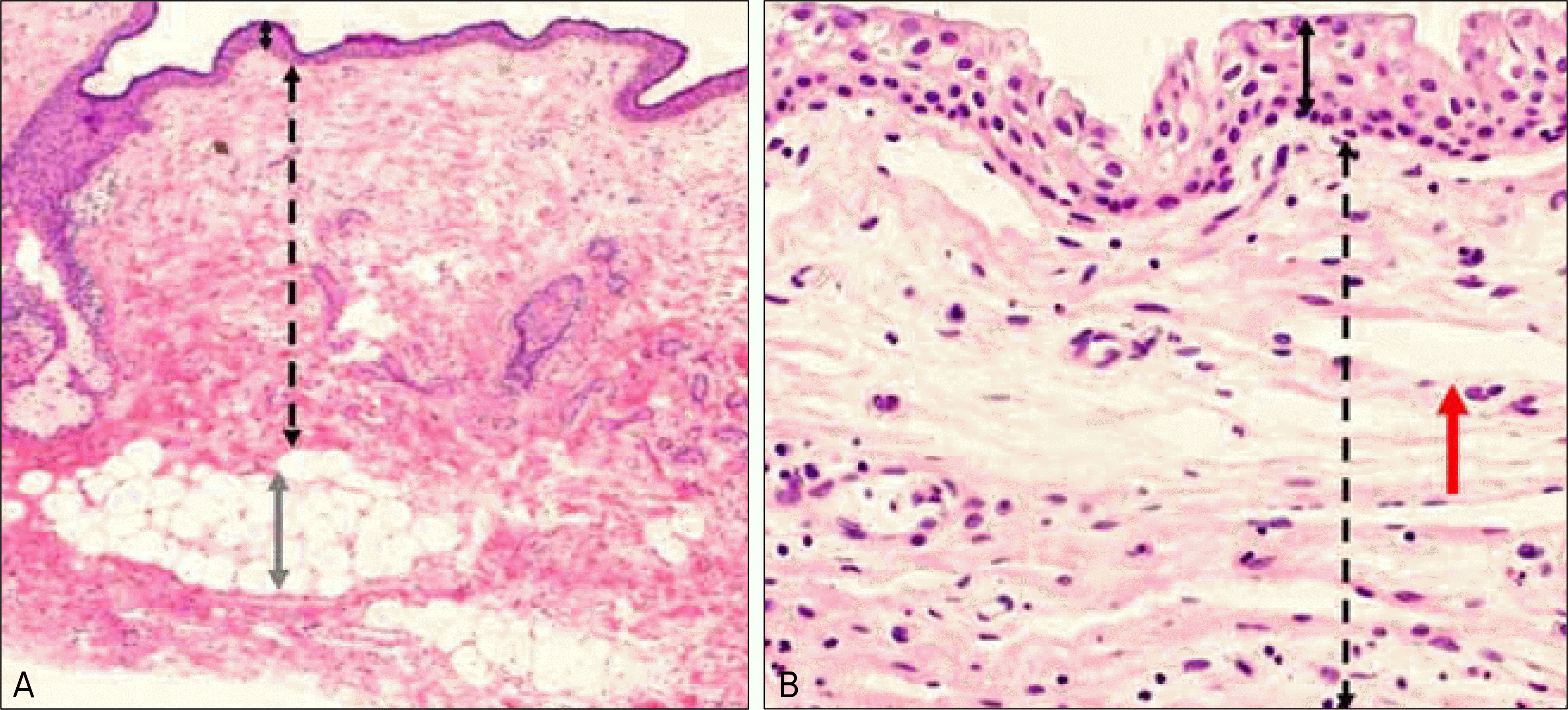 | Figure 2.Histopathologic findings of the eyelid and conjunctiva. (A) Histologic findings of the upper eyelid skin (Hematoxylin-eo-sin stain, ×50). Black arrow indicates epidermis, dotted arrow indicates dermis and gray arrow is subcutaneous fat. (B) Histologic findings of the conjunctiva (Hematoxylin-eosin stain, ×100). Black arrow indicates epithelium, dotted arrow indicates substantia propria and red arrow denotes lymphangiectasia. |
 | Figure 3.Collagen density of the upper eyelid skin and conjunctiva. (A, B, C) Collagen density of upper eyelid skin (Trichrome stain, ×400). (A) Grade 3, high collagen density. (B) Grade 2, moderate collagen density. (C) Grade 1, low collagen density. (D, E, F) Collagen density of conjunctiva (Trichrome stain, ×400). (D) Grade 3, high collagen density. (E) Grade 2, moderate collagen density. (F) Grade 1, low collagen density. |
 | Figure 4.Elastic degeneration of upper eyelid skin and conjunctiva. (A, B, C) Elastic degeneration of the upper eyelid skin (Verhoeff Van Gieson stain, ×400). (A) Grade 1, mild elastic degeneration. (B) Grade 2, moderate elastic degeneration. (C) Grade 3, severe elastic degeneration. (D, E, F) Elastic degeneration of the conjunctiva (Verhoeff Van Gieson stain, ×400). (D) Grade 1, mild elastic degeneration. (E) Grade 2, moderate elastic degeneration. (F) Grade 3, severe elastic degeneration. |
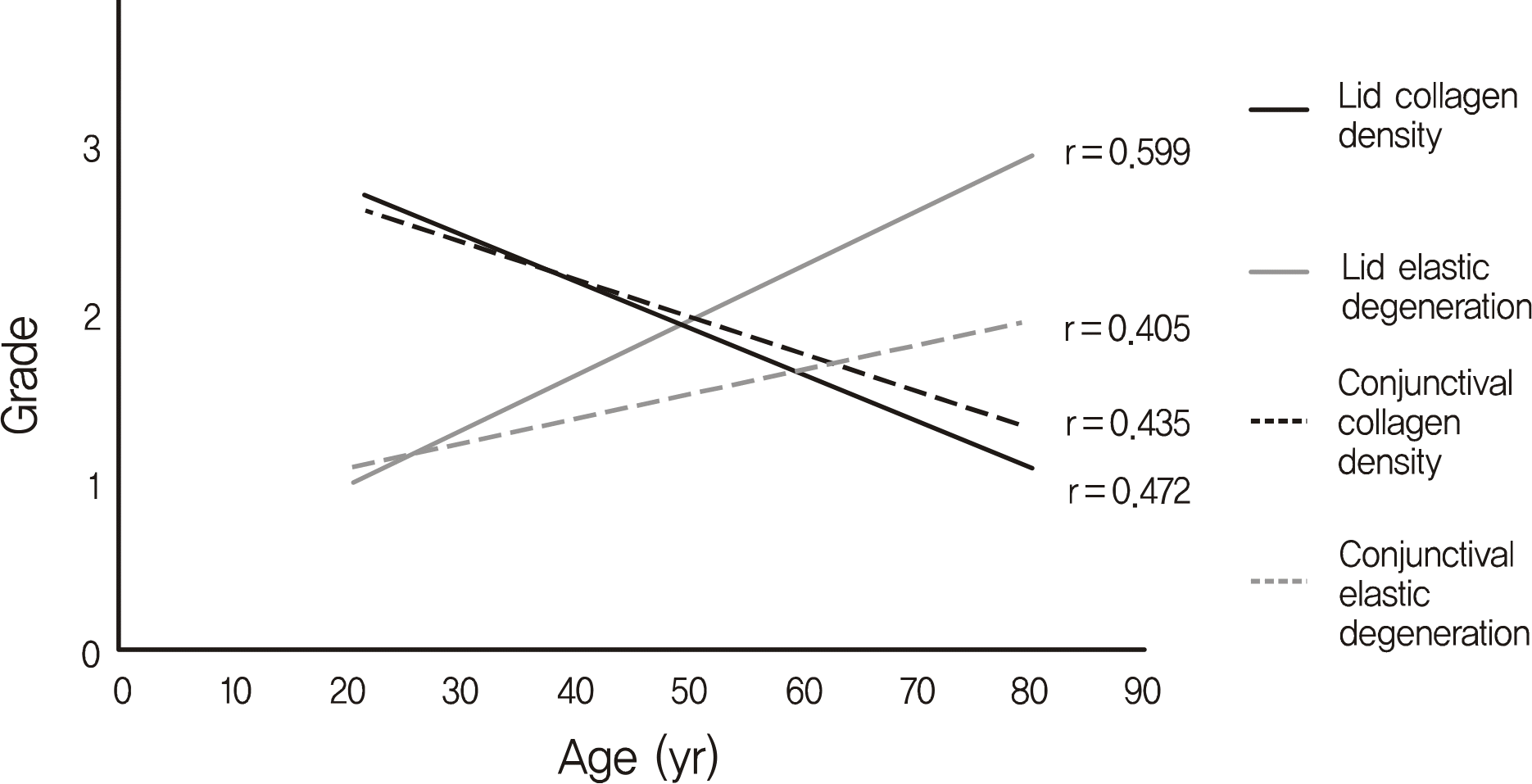 | Figure 5.Association between age and histologic findings of the eyelid and conjunctiva in dermatochalasis patients. Collagen density & elastic degeneration were significantly correlated with age regarding histologic findings of the eyelid skin and conjunctiva. Lid collagen density (p < 0.001) and conjunctival collagen density (p = 0.001) noted to decrease according to age. Lid elastic degeneration (p = 0.001) and conjunctival elastic degeneration (p < 0.001) were noted to decrease according to age. |
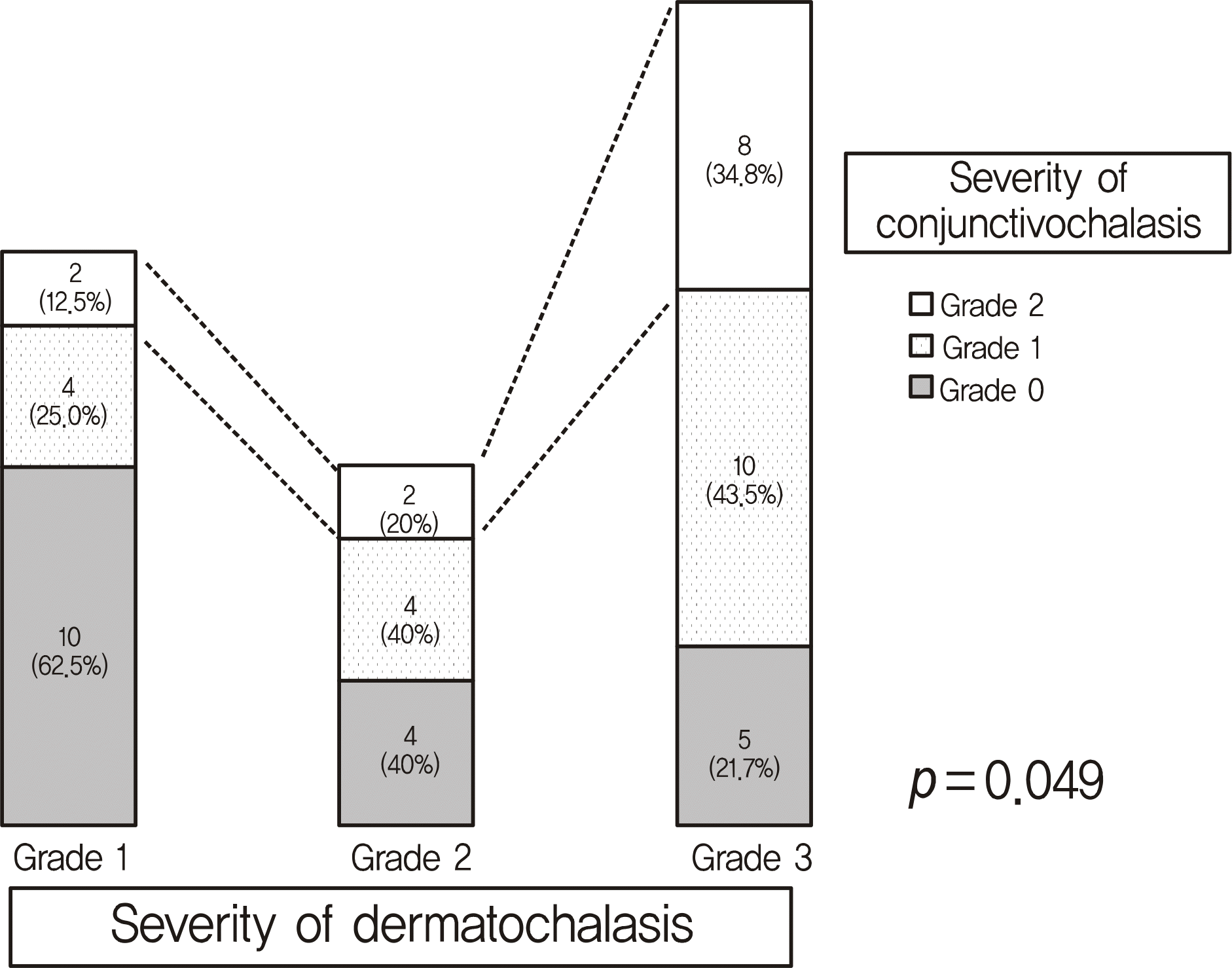 | Figure 6.Association between severity of dermatochalasis and conjunctivochalasis. Clinical severity of dermatochalasis tends to be related proportionally with the severity of conjunctivochalasis. |
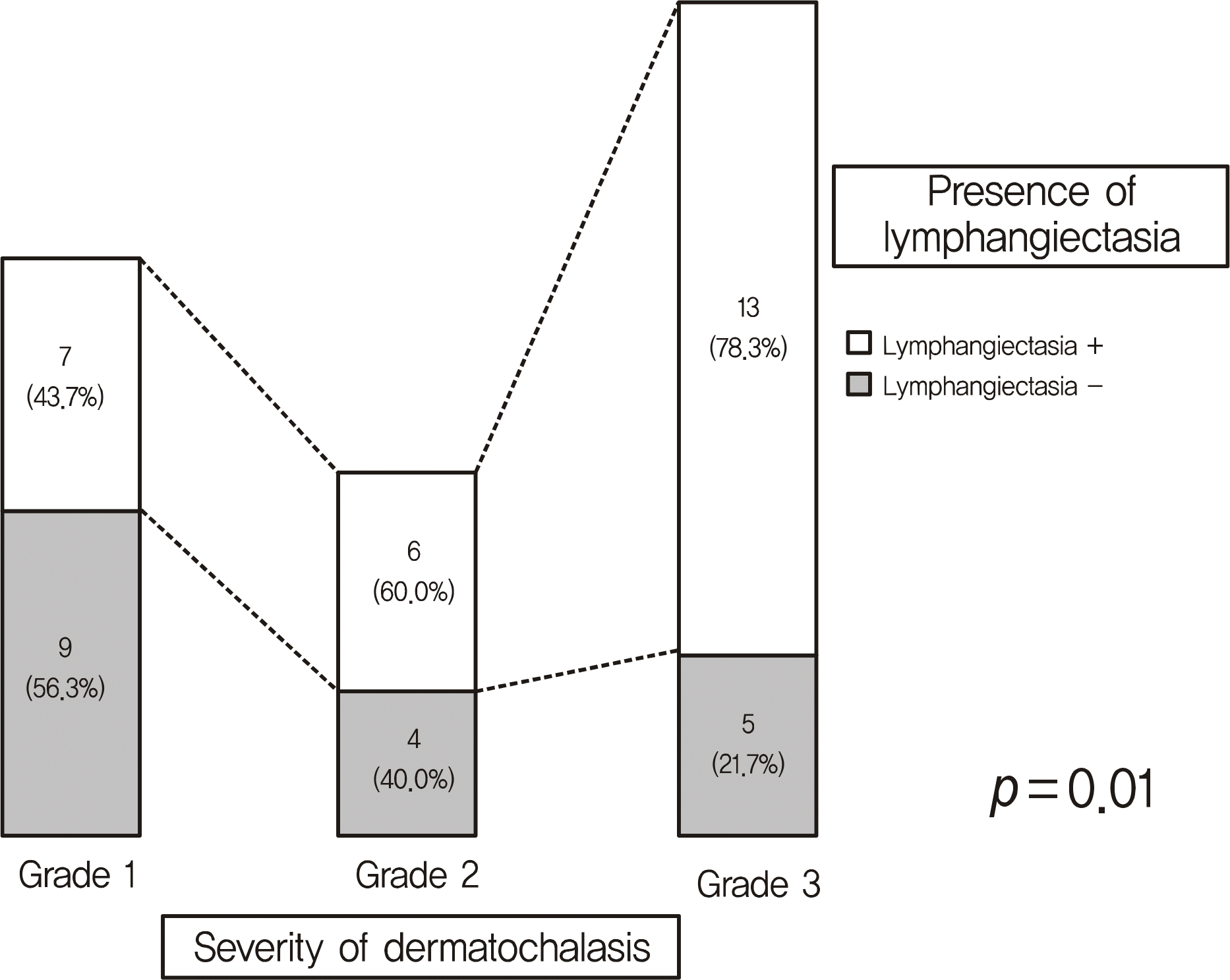 | Figure 7.Association between clinical severity of dermatochalasis and conjunctival lymphangiectasia. Clinical severity of dermatochalasis is significantly associated with presence of conjunctival lymphangiectasia (p = 0.01). |
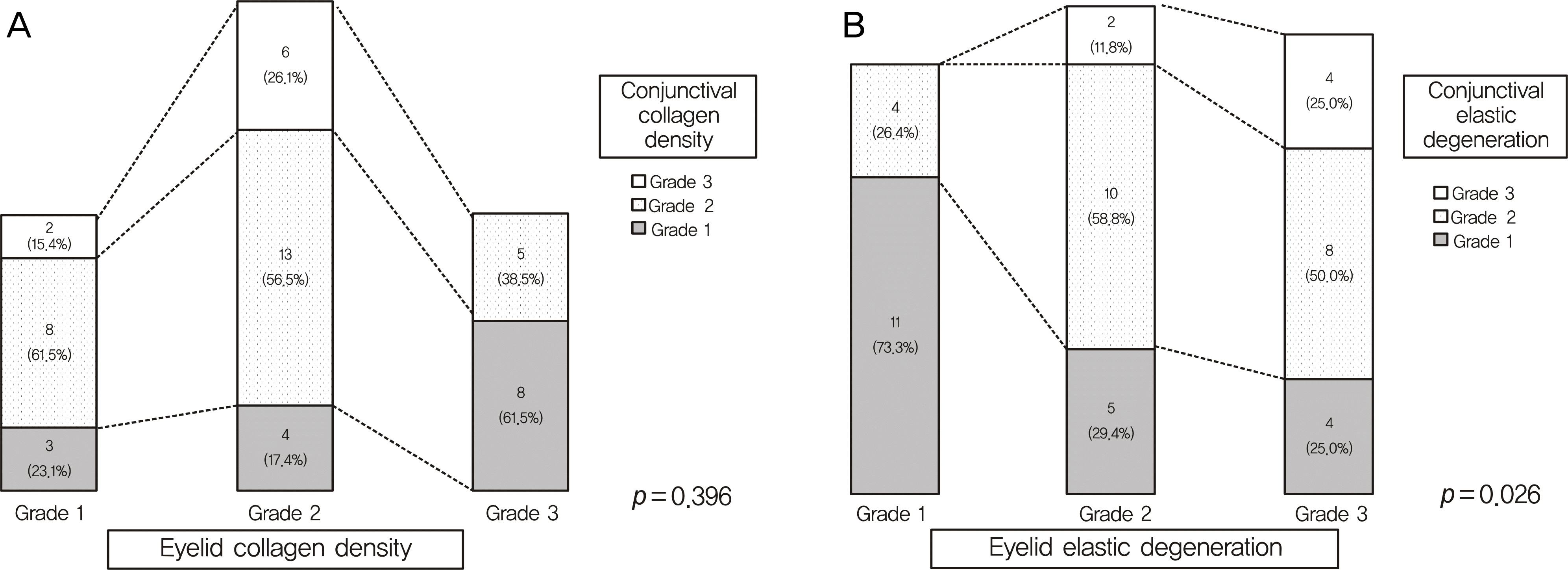 | Figure 8.Associations of histologic findings between eyelid skin and conjunctiva in the dermatochalasis patients. (A) Collagen density between the eyelid skin and conjunctiva is not significantly associated (p = 0.396), (B) eyelid skin elastic degeneration is significantly related to conjunctival elastic degeneration (p = 0.026). |
Table 1.
| Grade | |
|---|---|
| 0 | No persistent fold |
| 1 | Single, small fold |
| 2 | More than two folds and not higher than the tear meniscus |
| 3 | Multiple folds and higher than the tear meniscus |
Table 2.
| Factors | |
|---|---|
| Age (mean ± SD, yr) Distribution of age | 54.9 ± 20.5 |
| <40 | 7 |
| 41-50 | 2 |
| 51-60 | 2 |
| 61-70 | 11 |
| >71 | 5 |
| Sex | |
| Male | 5 (18.5%) |
| Female | 22 (72.5%) |
| Laterality | |
| OD | 25 (51.0%) |
| OS | 24 (49.0%) |
Table 3.
| Age (yr) | Epidermis (mean ± SD, μm) | Dermis (mean ± SD, μm) |
|---|---|---|
| <40 | 48.72 ± 14.37 | 512.54 ± 137.63 |
| 41-50 | 48.50 ± 8.10 | 632.50 ± 98.78 |
| 51-60 | 35.00 ± 4.08 | 690.00 ± 27.08 |
| 61-70 | 45.68 ± 9.54 | 673.86 ± 164.38 |
| >71 | 44.50 ± 6.71 | 605.00 ± 157.11 |
| Total | 45.50 ± 10.40 | 624.3 ± 156.30 |
| p-value* | 0.274 | 0.154 |
Table 4.
| Site | Clinical severity score |
Histologic grading |
||
|---|---|---|---|---|
| Collagen density‡ | Elastic degeneration§ | Lymphangiectasia∏ | ||
| Eyelid* | 1 (n = 16) | 2.4 | 1.2 | |
| 2 (n = 10) | 1.9 | 1.8 | ||
| 3 (n = 23) | 1.7 | 2.7 | ||
| p-value | p = 0.013 | p < 0.001 | ||
| Conjunctiva† | 0 (n = 20) | 1.0 | 2.4 | 0.5 |
| 1 (n = 22) | 0.8 | 2.1 | 0.6 | |
| 2 (n = 7) | 0.3 | 1.2 | 0.7 | |
| p-value | p < 0.001 | p < 0.001 | p < 0.001 | |
* Clinical severity of dermatochalasis were classified from 1 to 3: grade 1, hanging skin margin above the upper eyelid skin margin; grade 2, hanging skin margin on the lid margin; grade 3, hanging skin margin below the lid margin.;
† Clinical severity of conjunctivochalasis were classified according to conjunctival fold and tear meniscus height: grade 0, no persistent fold; grade 1, single small fold; grade 2, more than two folds and not higher than the tear meniscus.;
‡ Collagen density was scored from 1 to 3: grade 1, low collagen density; grade 2, moderate collagen density; grade 3, high collagen density.;




 PDF
PDF ePub
ePub Citation
Citation Print
Print


 XML Download
XML Download